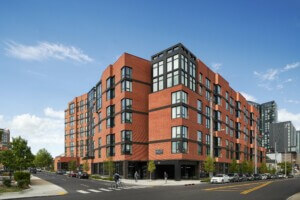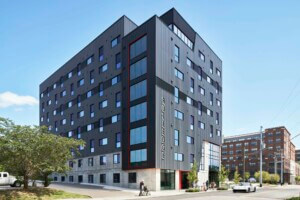Skywalks, or elevated sidewalks, continually resurface as an urban solution to alleviate pedestrian traffic, provide additional retail space, and offer a safe alternative to sharing space with automobiles. However, each time a skywalk is actually realized, problems abound.
The original elevated sidewalks are in Chester, England, and are believed to have been built in at least one iteration in the 13th century. Historians are unsure if the elevated sidewalks were implemented for retail opportunities or as flooding precaution, or both. Protected as a heritage site today, the Chester Rows inspired several master plans in the United States, particularly at the turn of the 20th century.
In 1913, Scientific American published “The Elevated Sidewalk: How it Will Solve City Transportation Problems,” which made the logical claim that humans and cars shouldn’t be in the same place. Imposing traffic regulations would slow cars down, and having people and cars sharing the streets is dangerous. The proposal was to make Manhattan a “city of bridges” with pedestrians moving safely above ground while cars sped underneath. Yet this never happened in lieu of the signs and traffic regulations we use today.
In the ’60s, the idea of the elevated sidewalk resurged in nearly two dozen towns, including rather unlikely places such as Cincinnati, Ohio, Minneapolis, Minnesota, and Morristown, Tennessee.
The Minneapolis Skyway system was built in 1962 and had the added benefit of providing a climate-controlled path through the city in intense weather. For that same reason, St. Paul also implemented a similar Skyway.
However, the pros are offset by some solid drawbacks—property disputes mean that it is often confusing as to who is responsible for maintaining the skywalks and a lack of commercial real estate along the walkways renders them desolate and perceived by the public as dangerous and crime-filled. Poor planning means that the sidewalks can be confusing and require maps; one example in particular is the “skyway to nowhere” on Wabasha Street in Minneapolis, which doesn’t connect to anything at all.
Inspired by Minneapolis, the city of Cincinnati created its own robust skywalk system that opened in 1971 to help downtown retailers compete with enclosed malls and make it easier to navigate the downtown area. More segments were added well through the ’90s, and for awhile, appear to be used quite regularly. But by 2002, the skywalks were falling into disrepair and the city’s “2002 Center City Plan” found that they actually were causing downtown economic activity to decline. The plan reported that when pedestrians bypassed the street, it made the downtown look abandoned and thus, a less desirable place to linger and spend money. In 2005, then-mayor Charlie Luken told The New York Times that the Skywalk is “ugly” and the space underneath is “yucky.” The skyway is slowly being dismantled one chunk at a time.
Morristown is particularly fraught over its elevated skywalk system, called the SkyMart, that was built in 1962 after the downtown was flooded and the commercial district was nearly wiped out. As was commonly the case around the country, the walkway system did not succeed in competing with malls, proved to be expensive to maintain, and, overall, did not live up to the expectations of the civic leaders.
In one camp, supporters believe it is unique to the city and a “national treasure.” The other side deems it to be a hindrance to progress, unnecessarily expensive, and underused. It was submitted to the National Register of Historic Places in the early 1990s, but it was denied. Recently, the East Tennessee Preservation Alliance posted an article on Facebook in support of the SkyMart. Comments in response offer insight into the local’s perspective.
“Oh, are there businesses on the second level?” asked a commenter. “Yes! Downtown Crossroads Association’s office is on the skywalk,” responded another. “One?” the original commenter replied. There was no response.
This seems to be the wide sweeping problem in all cities with elevated skywalks. Instead of bustling hubs of commerce and safe, weather-protected passageways through cities, they are deserted, confusing, and/or dangerous. Similar issues arise in tunnel systems built in cities like Dallas and Houston. “It was the worst urban planning decision that Dallas has ever made. They thought it was hip and groovy to create an underground community, but it was a death knell,” Dallas Mayor Laura Miller told The New York Times in 2005.
It’s a little unclear to us why this seems to be the case over and over again. Successful skywalks exist in Hong Kong, Copenhagen recently installed a popular bike skyway, and Mumbai is currently building out its skywalk system that, while controversial, is actively being used. Population density of American cities versus Asian or European cities or simple human preferences of habit could contribute to their failure.
Let AN know: Why do you think skywalks have been unsuccessful? Alternatively, if you know of a successful skywalk, tell us about it in the comments below.










